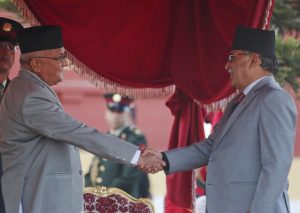Nepal’s political parties, notorious for their political promiscuity, have changed partners yet again.
Barely four months after the Communist Party of Nepal-United Marxist Leninist (CPN-UML) joined hands with the ruling CPN-Maoist Center (CPN-MC) to form a government, it struck a power-sharing deal at midnight on July 1 with its former nemesis, the Nepali Congress (NC), to form a new “national consensus government.”
The NC with 89 seats and the CPN-UML with 78 seats will have a combined strength of 167 seats — more than a simple majority — in the 275-member House of Representatives.
With the CPN-UML withdrawing support from the CPN-MC-led coalition government on July 3, Prime Minister Pushpa Kamal Dahal now presides over a minority government. His party, the CPN-MC, has just 32 seats and some of his allies in the coalition could ditch him to join the NC-CPN-UML government.
Dahal has decided not to resign. He will have to face a vote of confidence in parliament within 30 days. This is his fifth confidence vote in a year and a half. Given the current equation, he is likely to lose.
However, should the other “given” in Nepali politics – the willingness of parties to switch partners to forge new alliances to make or break governments – come into play in the run-up to the confidence vote, the possibility of Dahal hanging on to power cannot be ruled out.
After leading a powerful insurgency for a decade, Dahal turned to mainstream politics. On December 26, 2022, he was sworn in as prime minister for the third time, despite having stood a distant third — after the NC and the CPN-UML — in the general elections a month earlier. He has switched sides three times between the NC and CPN-ML since then. He ditched the NC at the altar in December 2022 to join hands with the CPN-UML. Then in February 2023, he dumped the CPN-UML to enter into an alliance with the NC. In March this year, Dahal discarded the NC to align with the CPN-UML again.
After winning the 2017 general elections, the CPN-UML and the CPN-MC merged to form the Communist Party of Nepal in 2018. The relationship began to unravel soon with then-Prime Minister Khadga Prasad Oli of the CPN-UML refusing to consult Dahal. Infighting paralyzed governance and the two parties fell apart.
Many had predicted that the bitter memories of that period would prevent them from joining hands ever again. That forecast was flawed as Oli and Dahal have aligned twice since then.
There are no permanent friends or foes in Nepali politics, and Dahal will use the coming weeks to win the NC or the CPN-UML back into an alliance with him. “We will engage in discussions with various parties, including the Rashtriya Swatantra Party (RSP), Nepali Congress, and CPN-UML, so as to save the coalition,” Dahal reportedly said.
Under the July 1 agreement, CPN-UML’s Oli and Sher Bahadur Deuba of the NC will take turns as prime minister for 18 months each until the next general election in 2027. Seventy-three-year-old Oli will take the steering wheel first; it will be his fourth stint as prime minister, while Deuba, 78, who first became prime minister in 1995, will head the government for the sixth time should the July 1 deal go according to plan.
The NC and CPN-UML have reportedly tentatively agreed on the division of ministerial portfolios — NC will head 10 ministries, including home, and the CPN-UML nine, including finance.
The two parties have claimed they have come together to amend the 2015 Nepali Constitution for political stability. Not everyone is convinced.
This claim “lacks credibility,” political scientist Krishna Khanal told The Hindu. “It’s only for public consumption.”
It is widely believed that the decision of the NC and the CPN-UML to oust the Dahal government is aimed at pre-empting corruption cases into recent scandals involving top leaders of the two parties. While NC leaders are said to be linked to the fake refugee scandal, CPN-UML leaders are reportedly involved in a tea estate land scam.
Even if the NC and CPN-UML are sincere about their claimed intentions to amend the constitution, it will be hard to achieve.
Constitutional amendments require a two-thirds majority in both houses of parliament. The NC and UML will need 18 more votes in the lower house to cobble up the two-thirds majority, which they could obtain with the support of smaller parties. In the upper house, they will need the support of all parties except the CPN-MC to get the necessary numbers. Besides, on any issue relating to the provinces, the provincial legislatures too must approve the amendments with a two-thirds majority.
Clearly, the road ahead to constitutional amendment will not be easy.
It may not be desirable either.
The amendment the NC and CPN-UML are reportedly considering is changing the electoral system. Nepal’s electoral system is a mixed one with 165 members of parliament elected under the First-Past-the-Post system and 110 elected under the proportional representation (PR) system.
Opponents of the current system say that the PR system prevents any party from securing a majority, which increases dependence on other parties and leads to political instability.
While this may be true, the PR system has its merits; it prevents landslide majorities and majoritarian rule, is more inclusive and provides leverage and voice to smaller parties and marginalized groups.
Doing away with the PR system is therefore a “regressive” move.
Importantly, it may not be the solution to Nepal’s political instability. While coalitions are hard to manage, making parties vulnerable to pressure from partners, it is not the electoral system that must be blamed for the frequent change of governments in Nepal.
It is the political promiscuity of parties and the formation of unprincipled alliances that lie at the heart of Nepal’s instability.

































